Functions | |
| void | iauA2af (int ndp, double angle, char *sign, int idmsf[4]) |
| Decompose radians into degrees, arcminutes, arcseconds, fraction. More... | |
| void | iauA2tf (int ndp, double angle, char *sign, int ihmsf[4]) |
| Decompose radians into hours, minutes, seconds, fraction. More... | |
| double | iauAnp (double a) |
| Normalize angle into the range 0 <= a < 2pi. More... | |
| double | iauAnpm (double a) |
| Normalize angle into the range -pi <= a < +pi. More... | |
| void | iauC2s (double p[3], double *theta, double *phi) |
| P-vector to spherical coordinates. More... | |
| void | iauCp (double p[3], double c[3]) |
| Copy a p-vector. More... | |
| void | iauCpv (double pv[2][3], double c[2][3]) |
| Copy a position/velocity vector. More... | |
| void | iauCr (double r[3][3], double c[3][3]) |
| Copy an r-matrix. More... | |
| void | iauD2tf (int ndp, double days, char *sign, int ihmsf[4]) |
| Decompose days to hours, minutes, seconds, fraction. More... | |
| void | iauIr (double r[3][3]) |
| Initialize an r-matrix to the identity matrix. More... | |
| void | iauP2pv (double p[3], double pv[2][3]) |
| Extend a p-vector to a pv-vector by appending a zero velocity. More... | |
| void | iauP2s (double p[3], double *theta, double *phi, double *r) |
| P-vector to spherical polar coordinates. More... | |
| double | iauPap (double a[3], double b[3]) |
| Position-angle from two p-vectors. More... | |
| double | iauPas (double al, double ap, double bl, double bp) |
| Position-angle from spherical coordinates. More... | |
| double | iauPdp (double a[3], double b[3]) |
| p-vector inner (=scalar=dot) product. More... | |
| double | iauPm (double p[3]) |
| Modulus of p-vector. More... | |
| void | iauPmp (double a[3], double b[3], double amb[3]) |
| P-vector subtraction. More... | |
| void | iauPn (double p[3], double *r, double u[3]) |
| Convert a p-vector into modulus and unit vector. More... | |
| void | iauPpp (double a[3], double b[3], double apb[3]) |
| P-vector addition. More... | |
| void | iauPpsp (double a[3], double s, double b[3], double apsb[3]) |
| P-vector scale and addition. More... | |
| void | iauPv2p (double pv[2][3], double p[3]) |
| Discard velocity component of a pv-vector. More... | |
| void | iauPv2s (double pv[2][3], double *theta, double *phi, double *r, double *td, double *pd, double *rd) |
| Convert position/velocity from Cartesian to spherical coordinates. More... | |
| void | iauPvdpv (double a[2][3], double b[2][3], double adb[2]) |
| Inner (=scalar=dot) product of two pv-vectors. More... | |
| void | iauPvm (double pv[2][3], double *r, double *s) |
| Modulus of pv-vector. More... | |
| void | iauPvmpv (double a[2][3], double b[2][3], double amb[2][3]) |
| Subtract one pv-vector from another. More... | |
| void | iauPvppv (double a[2][3], double b[2][3], double apb[2][3]) |
| Add one pv-vector to another. More... | |
| void | iauPvu (double dt, double pv[2][3], double upv[2][3]) |
| Update a pv-vector. More... | |
| void | iauPvup (double dt, double pv[2][3], double p[3]) |
| Update a pv-vector, discarding the velocity component. More... | |
| void | iauPvxpv (double a[2][3], double b[2][3], double axb[2][3]) |
| Outer (=vector=cross) product of two pv-vectors.Notes: More... | |
| void | iauPxp (double a[3], double b[3], double axb[3]) |
| p-vector outer (=vector=cross) product. More... | |
| void | iauRm2v (double r[3][3], double w[3]) |
| Express an r-matrix as an r-vector. More... | |
| void | iauRv2m (double w[3], double r[3][3]) |
| Form the r-matrix corresponding to a given r-vector. More... | |
| void | iauRx (double phi, double r[3][3]) |
| Rotate an r-matrix about the x-axis. More... | |
| void | iauRxp (double r[3][3], double p[3], double rp[3]) |
| Multiply a p-vector by an r-matrix. More... | |
| void | iauRxpv (double r[3][3], double pv[2][3], double rpv[2][3]) |
| Multiply a pv-vector by an r-matrix. More... | |
| void | iauRxr (double a[3][3], double b[3][3], double atb[3][3]) |
| Multiply two r-matrices. More... | |
| void | iauRy (double theta, double r[3][3]) |
| Rotate an r-matrix about the y-axis. More... | |
| void | iauRz (double psi, double r[3][3]) |
| Rotate an r-matrix about the z-axis. More... | |
| void | iauS2c (double theta, double phi, double c[3]) |
| Convert spherical coordinates to Cartesian. More... | |
| void | iauS2p (double theta, double phi, double r, double p[3]) |
| Convert spherical polar coordinates to p-vector. More... | |
| void | iauS2xpv (double s1, double s2, double pv[2][3], double spv[2][3]) |
| Multiply a pv-vector by two scalars. More... | |
| double | iauSepp (double a[3], double b[3]) |
| Angular separation between two p-vectors. More... | |
| double | iauSeps (double al, double ap, double bl, double bp) |
| Angular separation between two sets of spherical coordinates. More... | |
| void | iauSxp (double s, double p[3], double sp[3]) |
| Multiply a p-vector by a scalar. More... | |
| void | iauSxpv (double s, double pv[2][3], double spv[2][3]) |
| Multiply a pv-vector by a scalar. More... | |
| void | iauTr (double r[3][3], double rt[3][3]) |
| Transpose an r-matrix. More... | |
| void | iauTrxp (double r[3][3], double p[3], double trp[3]) |
| Multiply a p-vector by the transpose of an r-matrix. More... | |
| void | iauTrxpv (double r[3][3], double pv[2][3], double trpv[2][3]) |
| Multiply a pv-vector by the transpose of an r-matrix. More... | |
| void | iauZp (double p[3]) |
| Zero a p-vector. More... | |
| void | iauZpv (double pv[2][3]) |
| Zero a pv-vector. More... | |
| void | iauZr (double r[3][3]) |
| Initialize an r-matrix to the null matrix. More... | |
Detailed Description
Function Documentation
◆ iauA2af()
| void iauA2af | ( | int | ndp, |
| double | angle, | ||
| char * | sign, | ||
| int | idmsf[4] | ||
| ) |
Decompose radians into degrees, arcminutes, arcseconds, fraction.
1) The argument ndp is interpreted as follows:
ndp resolution
: ...0000 00 00
-7 1000 00 00
-6 100 00 00
-5 10 00 00
-4 1 00 00
-3 0 10 00
-2 0 01 00
-1 0 00 10
0 0 00 01
1 0 00 00.1
2 0 00 00.01
3 0 00 00.001
: 0 00 00.000...
* 2) The largest positive useful value for ndp is determined by the size of angle, the format of doubles on the target platform, and the risk of overflowing idmsf[3]. On a typical platform, for angle up to 2pi, the available floating-point precision might correspond to ndp=12. However, the practical limit is typically ndp=9, set by the capacity of a 32-bit int, or ndp=4 if int is only 16 bits.
3) The absolute value of angle may exceed 2pi. In cases where it does not, it is up to the caller to test for and handle the case where angle is very nearly 2pi and rounds up to 360 degrees, by testing for idmsf[0]=360 and setting idmsf[0-3] to zero.
- Parameters
-
[in] ndp resolution [in] angle angle in radians [out] sign '+' or '-' [out] idmsf degrees, arcminutes, arcseconds, fraction

◆ iauA2tf()
| void iauA2tf | ( | int | ndp, |
| double | angle, | ||
| char * | sign, | ||
| int | ihmsf[4] | ||
| ) |
Decompose radians into hours, minutes, seconds, fraction.
1) The argument ndp is interpreted as follows:
ndp resolution
: ...0000 00 00
-7 1000 00 00
-6 100 00 00
-5 10 00 00
-4 1 00 00
-3 0 10 00
-2 0 01 00
-1 0 00 10
0 0 00 01
1 0 00 00.1
2 0 00 00.01
3 0 00 00.001
: 0 00 00.000...
* 2) The largest positive useful value for ndp is determined by the size of angle, the format of doubles on the target platform, and the risk of overflowing ihmsf[3]. On a typical platform, for angle up to 2pi, the available floating-point precision might correspond to ndp=12. However, the practical limit is typically ndp=9, set by the capacity of a 32-bit int, or ndp=4 if int is only 16 bits.
3) The absolute value of angle may exceed 2pi. In cases where it does not, it is up to the caller to test for and handle the case where angle is very nearly 2pi and rounds up to 24 hours, by testing for ihmsf[0]=24 and setting ihmsf[0-3] to zero.
- Parameters
-
[in] ndp resolution [in] angle angle in radians [out] sign '+' or '-' [out] ihmsf hours, minutes, seconds, fraction

◆ iauAnp()
| double iauAnp | ( | double | a | ) |
Normalize angle into the range 0 <= a < 2pi.
- Parameters
-
[in] a angle (radians)
- Returns
- angle in range 0-2pi
◆ iauAnpm()
| double iauAnpm | ( | double | a | ) |
Normalize angle into the range -pi <= a < +pi.
- Parameters
-
[in] a angle (radians)
- Returns
- angle in range +/-pi
◆ iauC2s()
| void iauC2s | ( | double | p[3], |
| double * | theta, | ||
| double * | phi | ||
| ) |
P-vector to spherical coordinates.
- Parameters
-
[in] p p-vector [out] theta longitude angle (radians) [out] phi latitude angle (radians)
Notes:
1) The vector p can have any magnitude; only its direction is used.
2) If p is null, zero theta and phi are returned.
3) At either pole, zero theta is returned.
◆ iauCp()
| void iauCp | ( | double | p[3], |
| double | c[3] | ||
| ) |
Copy a p-vector.
- Parameters
-
[in] p p-vector to be copied [out] c copy
◆ iauCpv()
| void iauCpv | ( | double | pv[2][3], |
| double | c[2][3] | ||
| ) |
Copy a position/velocity vector.
- Parameters
-
[in] pv position/velocity vector to be copied [out] c copy

◆ iauCr()
| void iauCr | ( | double | r[3][3], |
| double | c[3][3] | ||
| ) |
Copy an r-matrix.
- Parameters
-
[in] r r-matrix to be copied [out] char[] copy

◆ iauD2tf()
| void iauD2tf | ( | int | ndp, |
| double | days, | ||
| char * | sign, | ||
| int | ihmsf[4] | ||
| ) |
Decompose days to hours, minutes, seconds, fraction.
- Parameters
-
[in] ndp resolution (Note 1) [in] days interval in days [out] sign '+' or '-' [out] ihmsf hours, minutes, seconds, fraction
Notes:
1) The argument ndp is interpreted as follows:
* ndp resolution * : ...0000 00 00 * -7 1000 00 00 * -6 100 00 00 * -5 10 00 00 * -4 1 00 00 * -3 0 10 00 * -2 0 01 00 * -1 0 00 10 * 0 0 00 01 * 1 0 00 00.1 * 2 0 00 00.01 * 3 0 00 00.001 * : 0 00 00.000... *
2) The largest positive useful value for ndp is determined by the size of days, the format of double on the target platform, and the risk of overflowing ihmsf[3]. On a typical platform, for days up to 1.0, the available floating-point precision might correspond to ndp=12. However, the practical limit is typically ndp=9, set by the capacity of a 32-bit int, or ndp=4 if int is only 16 bits.
3) The absolute value of days may exceed 1.0. In cases where it does not, it is up to the caller to test for and handle the case where days is very nearly 1.0 and rounds up to 24 hours, by testing for ihmsf[0]=24 and setting ihmsf[0-3] to zero.
◆ iauIr()
| void iauIr | ( | double | r[3][3] | ) |
Initialize an r-matrix to the identity matrix.
Returned:
- Parameters
-
[out] r r-matrix
◆ iauP2pv()
| void iauP2pv | ( | double | p[3], |
| double | pv[2][3] | ||
| ) |
Extend a p-vector to a pv-vector by appending a zero velocity.
- Parameters
-
[in] p p-vector [out] pv pv-vector

◆ iauP2s()
| void iauP2s | ( | double | p[3], |
| double * | theta, | ||
| double * | phi, | ||
| double * | r | ||
| ) |
P-vector to spherical polar coordinates.
- Parameters
-
[in] p p-vector [out] theta longitude angle (radians) [out] phi latitude angle (radians) [out] r radial distance
Notes:
1) If P is null, zero theta, phi and r are returned.
2) At either pole, zero theta is returned.

◆ iauPap()
| double iauPap | ( | double | a[3], |
| double | b[3] | ||
| ) |
Position-angle from two p-vectors.
- Parameters
-
[in] a direction of reference point [in] b direction of point whose PA is required
- Returns
- position angle of b with respect to a (radians)
Notes:
1) The result is the position angle, in radians, of direction b with respect to direction a. It is in the range -pi to +pi. The sense is such that if b is a small distance "north" of a the position angle is approximately zero, and if b is a small distance "east" of a the position angle is approximately +pi/2.
2) The vectors a and b need not be of unit length.
3) Zero is returned if the two directions are the same or if either vector is null.
4) If vector a is at a pole, the result is ill-defined.
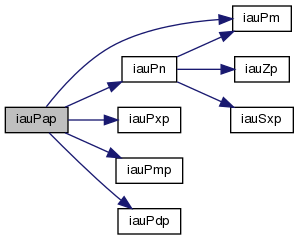
◆ iauPas()
| double iauPas | ( | double | al, |
| double | ap, | ||
| double | bl, | ||
| double | bp | ||
| ) |
Position-angle from spherical coordinates.
- Parameters
-
[in] al longitude of point A (e.g. RA) in radians [in] ap latitude of point A (e.g. Dec) in radians [in] bl longitude of point B [in] bp latitude of point B
- Returns
- position angle of B with respect to A
Notes:
1) The result is the bearing (position angle), in radians, of point B with respect to point A. It is in the range -pi to +pi. The sense is such that if B is a small distance "east" of point A, the bearing is approximately +pi/2.
2) Zero is returned if the two points are coincident.
◆ iauPdp()
| double iauPdp | ( | double | a[3], |
| double | b[3] | ||
| ) |
p-vector inner (=scalar=dot) product.
- Parameters
-
[in] a first p-vector [in] b second p-vector
- Returns
- a . b
◆ iauPm()
| double iauPm | ( | double | p[3] | ) |
Modulus of p-vector.
- Parameters
-
[in] p p-vector
- Returns
- modulus
◆ iauPmp()
| void iauPmp | ( | double | a[3], |
| double | b[3], | ||
| double | amb[3] | ||
| ) |
P-vector subtraction.
- Parameters
-
[in] a first p-vector [in] b second p-vector [out] amb a - b
Note: It is permissible to re-use the same array for any of the arguments.
◆ iauPn()
| void iauPn | ( | double | p[3], |
| double * | r, | ||
| double | u[3] | ||
| ) |
Convert a p-vector into modulus and unit vector.
- Parameters
-
[in] p p-vector [out] r modulus [out] u unit vector
Notes:
1) If p is null, the result is null. Otherwise the result is a unit vector.
2) It is permissible to re-use the same array for any of the arguments.
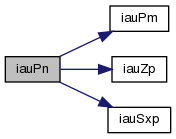
◆ iauPpp()
| void iauPpp | ( | double | a[3], |
| double | b[3], | ||
| double | apb[3] | ||
| ) |
P-vector addition.
- Parameters
-
[in] a first p-vector [in] b second p-vector [out] apb a + b
Note: It is permissible to re-use the same array for any of the arguments.
◆ iauPpsp()
| void iauPpsp | ( | double | a[3], |
| double | s, | ||
| double | b[3], | ||
| double | apsb[3] | ||
| ) |
P-vector scale and addition.
- Parameters
-
[in] a first p-vector [in] s scalar (multiplier for b) [in] b second p-vector [out] apsb a + s*b
Note: It is permissible for any of a, b and apsb to be the same array.

◆ iauPv2p()
| void iauPv2p | ( | double | pv[2][3], |
| double | p[3] | ||
| ) |
Discard velocity component of a pv-vector.
- Parameters
-
[in] pv pv-vector [out] p p-vector

◆ iauPv2s()
| void iauPv2s | ( | double | pv[2][3], |
| double * | theta, | ||
| double * | phi, | ||
| double * | r, | ||
| double * | td, | ||
| double * | pd, | ||
| double * | rd | ||
| ) |
Convert position/velocity from Cartesian to spherical coordinates.
- Parameters
-
[in] pv pv-vector [out] theta longitude angle (radians) [out] phi latitude angle (radians) [out] r radial distance [out] td rate of change of theta [out] pd rate of change of phi [out] rd rate of change of r
Notes:
1) If the position part of pv is null, theta, phi, td and pd are indeterminate. This is handled by extrapolating the position through unit time by using the velocity part of pv. This moves the origin without changing the direction of the velocity component. If the position and velocity components of pv are both null, zeroes are returned for all six results.
2) If the position is a pole, theta, td and pd are indeterminate. In such cases zeroes are returned for all three.
◆ iauPvdpv()
| void iauPvdpv | ( | double | a[2][3], |
| double | b[2][3], | ||
| double | adb[2] | ||
| ) |
Inner (=scalar=dot) product of two pv-vectors.
- Parameters
-
[in] a first pv-vector [in] b second pv-vector [out] adb a . b (see note)
Note:
If the position and velocity components of the two pv-vectors are ( ap, av ) and ( bp, bv ), the result, a . b, is the pair of numbers ( ap . bp , ap . bv + av . bp ). The two numbers are the dot-product of the two p-vectors and its derivative.

◆ iauPvm()
| void iauPvm | ( | double | pv[2][3], |
| double * | r, | ||
| double * | s | ||
| ) |
Modulus of pv-vector.
- Parameters
-
[in] pv pv-vector [out] r modulus of position component [out] s modulus of velocity component

◆ iauPvmpv()
| void iauPvmpv | ( | double | a[2][3], |
| double | b[2][3], | ||
| double | amb[2][3] | ||
| ) |
Subtract one pv-vector from another.
- Parameters
-
[in] a first pv-vector [in] b second pv-vector [out] amb a - b
Note: It is permissible to re-use the same array for any of the arguments.

◆ iauPvppv()
| void iauPvppv | ( | double | a[2][3], |
| double | b[2][3], | ||
| double | apb[2][3] | ||
| ) |
Add one pv-vector to another.
- Parameters
-
[in] a first pv-vector [in] b second pv-vector [out] apb a + b
Note: It is permissible to re-use the same array for any of the arguments.

◆ iauPvu()
| void iauPvu | ( | double | dt, |
| double | pv[2][3], | ||
| double | upv[2][3] | ||
| ) |
Update a pv-vector.
- Parameters
-
[in] dt time interval [in] pv pv-vector [out] upv p updated, v unchanged
Notes:
1) "Update" means "refer the position component of the vector to a new date dt time units from the existing date".
2) The time units of dt must match those of the velocity.
3) It is permissible for pv and upv to be the same array.
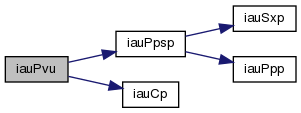
◆ iauPvup()
| void iauPvup | ( | double | dt, |
| double | pv[2][3], | ||
| double | p[3] | ||
| ) |
Update a pv-vector, discarding the velocity component.
- Parameters
-
[in] dt time interval [in] pv pv-vector [out] p p-vector
Notes:
1) "Update" means "refer the position component of the vector to a new date dt time units from the existing date".
2) The time units of dt must match those of the velocity.
◆ iauPvxpv()
| void iauPvxpv | ( | double | a[2][3], |
| double | b[2][3], | ||
| double | axb[2][3] | ||
| ) |
Outer (=vector=cross) product of two pv-vectors.Notes:
Outer (=vector=cross) product of two pv-vectors.
1) If the position and velocity components of the two pv-vectors are ( ap, av ) and ( bp, bv ), the result, a x b, is the pair of vectors ( ap x bp, ap x bv + av x bp ). The two vectors are the cross-product of the two p-vectors and its derivative.
2) It is permissible to re-use the same array for any of the arguments.
- Parameters
-
[in] a first pv -vector [in] b second pv -vector [out] axb ax b [in] a first pv-vector [in] b second pv-vector [out] axb a x b
Notes:
1) If the position and velocity components of the two pv-vectors are ( ap, av ) and ( bp, bv ), the result, a x b, is the pair of vectors ( ap x bp, ap x bv + av x bp ). The two vectors are the cross-product of the two p-vectors and its derivative.
2) It is permissible to re-use the same array for any of the arguments.
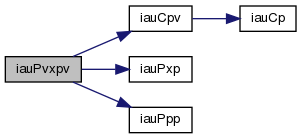
◆ iauPxp()
| void iauPxp | ( | double | a[3], |
| double | b[3], | ||
| double | axb[3] | ||
| ) |
p-vector outer (=vector=cross) product.
- Parameters
-
[in] a first p-vector [in] b second p-vector [out] axb a x b
Note: It is permissible to re-use the same array for any of the arguments.
◆ iauRm2v()
| void iauRm2v | ( | double | r[3][3], |
| double | w[3] | ||
| ) |
Express an r-matrix as an r-vector.
- Parameters
-
[in] r rotation matrix [out] w rotation vector (Note 1)
Notes:
1) A rotation matrix describes a rotation through some angle about some arbitrary axis called the Euler axis. The "rotation vector" returned by this function has the same direction as the Euler axis, and its magnitude is the angle in radians. (The magnitude and direction can be separated by means of the function iauPn.)
2) If r is null, so is the result. If r is not a rotation matrix the result is undefined; r must be proper (i.e. have a positive determinant) and real orthogonal (inverse = transpose).
3) The reference frame rotates clockwise as seen looking along the rotation vector from the origin.
◆ iauRv2m()
| void iauRv2m | ( | double | w[3], |
| double | r[3][3] | ||
| ) |
Form the r-matrix corresponding to a given r-vector.
- Parameters
-
[in] w rotation vector (Note 1) [out] r rotation matrix
Notes:
1) A rotation matrix describes a rotation through some angle about some arbitrary axis called the Euler axis. The "rotation vector" supplied to This function has the same direction as the Euler axis, and its magnitude is the angle in radians.
2) If w is null, the unit matrix is returned.
3) The reference frame rotates clockwise as seen looking along the rotation vector from the origin.
◆ iauRx()
| void iauRx | ( | double | phi, |
| double | r[3][3] | ||
| ) |
Rotate an r-matrix about the x-axis.
- Parameters
-
[in] phi angle (radians) [in,out] r r-matrix, rotated
Notes:
1) Calling this function with positive phi incorporates in the supplied r-matrix r an additional rotation, about the x-axis, anticlockwise as seen looking towards the origin from positive x.
2) The additional rotation can be represented by this matrix:
( 1 0 0 ) ( ) ( 0 + cos(phi) + sin(phi) ) ( ) ( 0 - sin(phi) + cos(phi) )
◆ iauRxp()
| void iauRxp | ( | double | r[3][3], |
| double | p[3], | ||
| double | rp[3] | ||
| ) |
Multiply a p-vector by an r-matrix.
- Parameters
-
[in] r r-matrix [in] p p-vector [out] rp r * p
Note: It is permissible for p and rp to be the same array.

◆ iauRxpv()
| void iauRxpv | ( | double | r[3][3], |
| double | pv[2][3], | ||
| double | rpv[2][3] | ||
| ) |
Multiply a pv-vector by an r-matrix.
- Parameters
-
[in] r r-matrix [in] pv pv-vector [out] rpv r * pv
Note: It is permissible for pv and rpv to be the same array.

◆ iauRxr()
| void iauRxr | ( | double | a[3][3], |
| double | b[3][3], | ||
| double | atb[3][3] | ||
| ) |
Multiply two r-matrices.
- Parameters
-
[in] a first r-matrix [in] b second r-matrix [out] atb a * b
Note: It is permissible to re-use the same array for any of the arguments.

◆ iauRy()
| void iauRy | ( | double | theta, |
| double | r[3][3] | ||
| ) |
Rotate an r-matrix about the y-axis.
- Parameters
-
[in] theta angle (radians) [in,out] r r-matrix, rotated
Notes:
1) Calling this function with positive theta incorporates in the supplied r-matrix r an additional rotation, about the y-axis, anticlockwise as seen looking towards the origin from positive y.
2) The additional rotation can be represented by this matrix:
( + cos(theta) 0 - sin(theta) ) ( ) ( 0 1 0 ) ( ) ( + sin(theta) 0 + cos(theta) )
◆ iauRz()
| void iauRz | ( | double | psi, |
| double | r[3][3] | ||
| ) |
Rotate an r-matrix about the z-axis.
- Parameters
-
[in] psi angle (radians) [in,out] r r-matrix, rotated
Notes:
1) Calling this function with positive psi incorporates in the supplied r-matrix r an additional rotation, about the z-axis, anticlockwise as seen looking towards the origin from positive z.
2) The additional rotation can be represented by this matrix:
( + cos(psi) + sin(psi) 0 ) ( ) ( - sin(psi) + cos(psi) 0 ) ( ) ( 0 0 1 )
◆ iauS2c()
| void iauS2c | ( | double | theta, |
| double | phi, | ||
| double | c[3] | ||
| ) |
Convert spherical coordinates to Cartesian.
- Parameters
-
[in] theta longitude angle (radians) [in] phi latitude angle (radians) [out] c direction cosines
◆ iauS2p()
| void iauS2p | ( | double | theta, |
| double | phi, | ||
| double | r, | ||
| double | p[3] | ||
| ) |
Convert spherical polar coordinates to p-vector.
- Parameters
-
[in] theta longitude angle (radians) [in] phi latitude angle (radians) [in] r radial distance [out] p Cartesian coordinates

◆ iauS2xpv()
| void iauS2xpv | ( | double | s1, |
| double | s2, | ||
| double | pv[2][3], | ||
| double | spv[2][3] | ||
| ) |
Multiply a pv-vector by two scalars.
- Parameters
-
[in] s1 scalar to multiply position component by [in] s2 scalar to multiply velocity component by [in] pv pv-vector [out] spv pv-vector: p scaled by s1, v scaled by s2
Note: It is permissible for pv and spv to be the same array.

◆ iauSepp()
| double iauSepp | ( | double | a[3], |
| double | b[3] | ||
| ) |
Angular separation between two p-vectors.
- Parameters
-
[in] a first p-vector (not necessarily unit length) [in] b second p-vector (not necessarily unit length)
- Returns
- angular separation (radians, always positive)
Notes:
1) If either vector is null, a zero result is returned.
2) The angular separation is most simply formulated in terms of scalar product. However, this gives poor accuracy for angles near zero and pi. The present algorithm uses both cross product and dot product, to deliver full accuracy whatever the size of the angle.
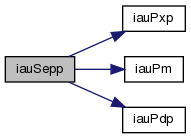
◆ iauSeps()
| double iauSeps | ( | double | al, |
| double | ap, | ||
| double | bl, | ||
| double | bp | ||
| ) |
Angular separation between two sets of spherical coordinates.
- Parameters
-
[in] al first longitude (radians) [in] ap first latitude (radians) [in] bl second longitude (radians) [in] bp second latitude (radians)
- Returns
- angular separation (radians)
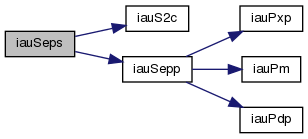
◆ iauSxp()
| void iauSxp | ( | double | s, |
| double | p[3], | ||
| double | sp[3] | ||
| ) |
Multiply a p-vector by a scalar.
- Parameters
-
[in] s scalar [in] p p-vector [out] sp s * p
Note: It is permissible for p and sp to be the same array.
◆ iauSxpv()
| void iauSxpv | ( | double | s, |
| double | pv[2][3], | ||
| double | spv[2][3] | ||
| ) |
Multiply a pv-vector by a scalar.
- Parameters
-
[in] s scalar [in] pv pv-vector [out] spv s * pv
Note: It is permissible for pv and spv to be the same array

◆ iauTr()
| void iauTr | ( | double | r[3][3], |
| double | rt[3][3] | ||
| ) |
Transpose an r-matrix.
- Parameters
-
[in] r r-matrix [out] rt transpose
Note: It is permissible for r and rt to be the same array.

◆ iauTrxp()
| void iauTrxp | ( | double | r[3][3], |
| double | p[3], | ||
| double | trp[3] | ||
| ) |
Multiply a p-vector by the transpose of an r-matrix.
- Parameters
-
[in] r r-matrix [in] p p-vector [out] trp r^T * p
Note: It is permissible for p and trp to be the same array.

◆ iauTrxpv()
| void iauTrxpv | ( | double | r[3][3], |
| double | pv[2][3], | ||
| double | trpv[2][3] | ||
| ) |
Multiply a pv-vector by the transpose of an r-matrix.
- Parameters
-
[in] r r-matrix [in] pv pv-vector [out] trpv r * pv
Note: It is permissible for pv and trpv to be the same array.

◆ iauZp()
| iauZp | ( | double | p[3] | ) |
Zero a p-vector.
Returned:
- Parameters
-
[out] p p-vector
◆ iauZpv()
| void iauZpv | ( | double | pv[2][3] | ) |
Zero a pv-vector.
Returned:
- Parameters
-
[out] pv pv-vector

◆ iauZr()
| void iauZr | ( | double | r[3][3] | ) |
Initialize an r-matrix to the null matrix.
Returned:
- Parameters
-
[out] r r-matrix
 1.8.16
1.8.16